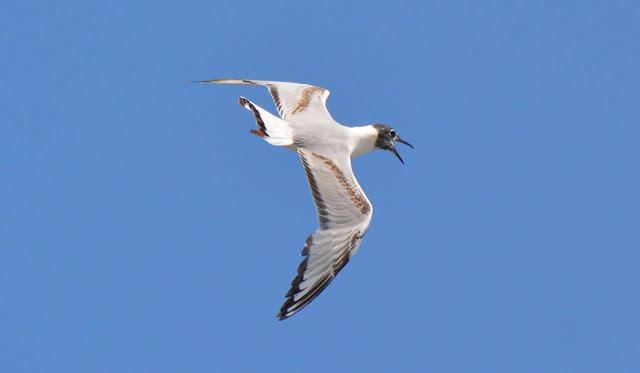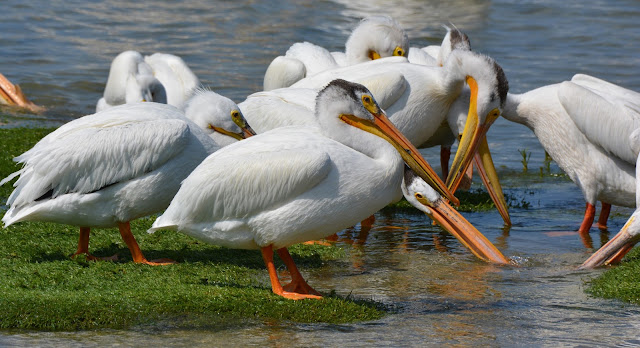The Wisconsin bird of the year has to be the American White Pelican. Their numbers attracted thousands of people along the Lake Michigan shoreline from Milwaukee to Door County. And their return is significant.
 |
| Caspian Terns surrounded by Ring-billed Gulls |
 |
| Nothing says sexy like a woman with a dead bird on her head. Photo courtesy of NPR |
The Great Lakes have also seen an invasion of exotic fish and marine life over the years. One fish I do remember well is the alewife. This tiny fish dies off in the thousands along the beaches of Lake Michigan during dramatic weather shifts in spring and early summer. The smell alone is terrible. And the coastline can be covered in piles of these fish as the currents force their sickly bodies closer to the shore. Over the years, towns along these areas have had to send in equipment to clean up the beaches. Take for example this recent report from Racine. I'd like to make a correction to the article. There are no such things as sea gulls. Just gulls.
 |
| A Forster's Tern stretches out the wings |
So back to the pelicans who were stealing the show. People from all over, in their friendly Wisconsin ways, would ask birders if those were indeed pelicans. Birders politely would tell them that they were. Then people would share their personal recollections about having never seen one growing up. And speaking for myself, it is shocking to see pelicans flying over the beach on a summer day. I mean, were we living in California? It's pretty amazing to see them fly in their "V" formations over the roads.
 |
| An angry Bonaparte's Gull |
 |
| Nellie cuddles up in her blanket. She'll have nothing to do with them birds. |
Don't get me wrong. I love the pelicans! But I also loved the gulls. I wanted to spend most of my time on the Lake and bird. Towards the latter part of my vacation, I went to the infamous Manitowoc Impoundment every day. It was cool and breezy with a great chance for rarities. Lots of rarities.
 |
| Lesser Black-backed Gull |
 |
| A 3rd cycle Great Black-backed Gull!!! This was shocking to me! I thought they wintered only in Two Rivers, but apparently not! Cool find! |
Former professor, Doc Sontag, was at it again. Every day at 2 PM he finds rarities for the Wisconsin crowd to chase at the Manitowoc Impoundment. On my last day, I wanted to say good-bye to this amazing fellow. And what followed afterwards was awesome......
 |
| Doc is wearing the brim hat with suspenders. Love that guy! |
 |
| Arctic Tern |
The Doc takes one for the team and begins chatting with the people about the pelicans. This guy is amazing. I think back on my times with him in class and remember how patient he was with me. And here again he shows the same courtesy and patience towards others. Flashback! In one corner of our lab, he had a pile of formaldehyde cats for study. Needless to say, I was a bit traumatized:) It was part of the curriculum and he was a great professor. Me? Well I could've done better. I was into the art of party and socializing. I remember during a time when we did blood testing in class. I hate blood and I almost passed out trying to prick my fingers like 500 times. It was like sticking a turnip! The lesson was about testing chromosomes. If I went back now as an adult, I would be a much better student. One of my favorite lessons with him was dominant and recessive gene traits. Doc, I failed you in the biology department but I hope to make up for it in the bird one:)
 |
| Caspian Tern |
Here is yet another positive about the pelicans. They became the unofficial ambassadors between birders and non-birders alike. Their presence caught the public's eye and a general interest for birds. And that's a good thing!
 |
| Franklin's Gull |
Because as we know, birds are simply amazing. They are meant to fly free. They inspire art. And they inspire so many of us.
It doesn't matter where we live. There is beauty everywhere we are. All we need to do is stop and look. It's really that easy but something we can often forget to do in our busy daily lives. And the pelicans did that for so many people.
Until next time......
 |
| Photo courtesy of NPR |














sounds quite the adventure was had. pelicans, new bird (arctic tern), gulls... i'd be a better student in certain areas now too. i think i have more of a curiosity now. as for the hats, i wouldn't own one with a dead animal of any kind. i'd rather be photographing the live ones. hope all is well. have a great day/ weekend~
ReplyDeleteCharlie Sontag! You know Charlie! I was relatively new in the UW Colleges Bio Department when he was our department Chair. What a lovely man - so glad he's still birding and that you all saw that Arctic Tern. Funny coincidence - I live in Green Valley in winter and happened onto your blog through Audubon there, but live in WI rest of the year.
ReplyDeleteIt certainly is a small world, isn't it?:) When you come back to Green Valley, let me know. We can do some birding:)
DeleteWonderful! I'd love that.
DeleteSuch an interesting post Chris and wonderful to read of the recovery of the pelicans and the women who saved them. Over here the Royal Society for the Protection of Birds (the RSPB) was set up by women against the use of birds' plumes in hats.
ReplyDeleteSo enjoy reading your posts detailing your wildlife sightings. As always the photos are superb :)
Keep on being a good bird ambassador Chris. The tedious and distracting questions are what Rangers deal with all the time. So wonderful to see this mentor of yours.
ReplyDelete